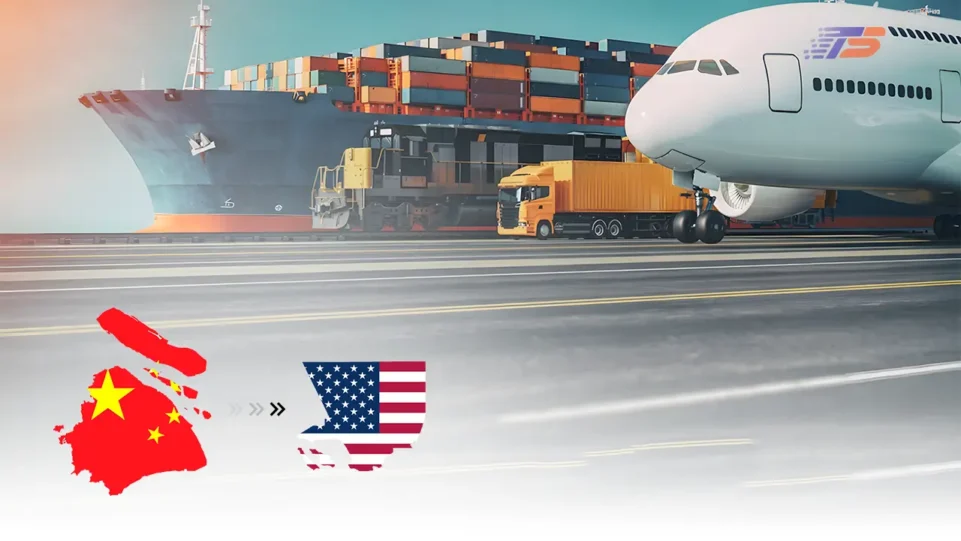Shipping from Singapore to US is one of the busiest global shipping routes, supporting over $100 billion in trade every year.
Millions of containers pass through Singapore’s advanced ports, supplying key U.S. markets such as Los Angeles, New York, and Houston.
This vital corridor connects Asia and North America, especially in electronics, machinery, and consumer goods.
In this guide, we’ll walk you through the essentials of managing shipments from Singapore to the USA covering the best shipping routes , customs procedures, and smart strategies to reduce costs while ensuring timely delivery.
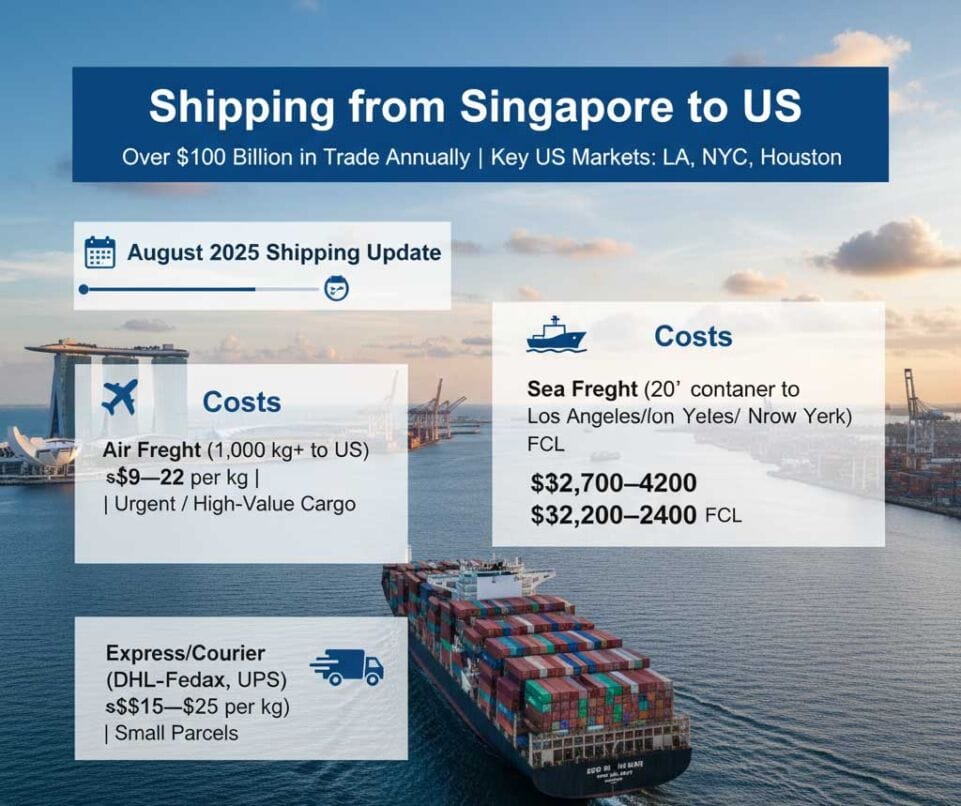
August 2025 Shipping Update: Singapore → US
Costs
- Air Freight (1,000 kg+ to US): ~$9–22 per kg | Best for urgent or high-value cargo
- Sea Freight (20′ container to Los Angeles/New York): ~$2,700–4,200 | Full Container Load (FCL)
- Sea Freight (40′ container to Los Angeles/New York): ~$2,200–2,400 | Full Container Load (FCL)
- Express/Courier (DHL, FedEx, UPS): Price varies by weight (~$15–$25 per kg) | Ideal for small parcels and urgent shipments
Delivery Times
| Mode | Route | Cost (USD) | Transit Time |
|---|---|---|---|
| Air Freight | Singapore → United States | ~$9–22 per kg | 3–7 days |
| Sea Freight (20′ container) | Singapore → Los Angeles / New York | ~$2,200–2,400 | 20–35 days |
| Sea Freight (40′ container) | Singapore → Los Angeles / New York | ~$2,500–5,000 | 20–35 days |
| Express / Courier | Singapore → United States | ~$15–25 per kg | 1–3 days |
Shipping Options from Singapore to US
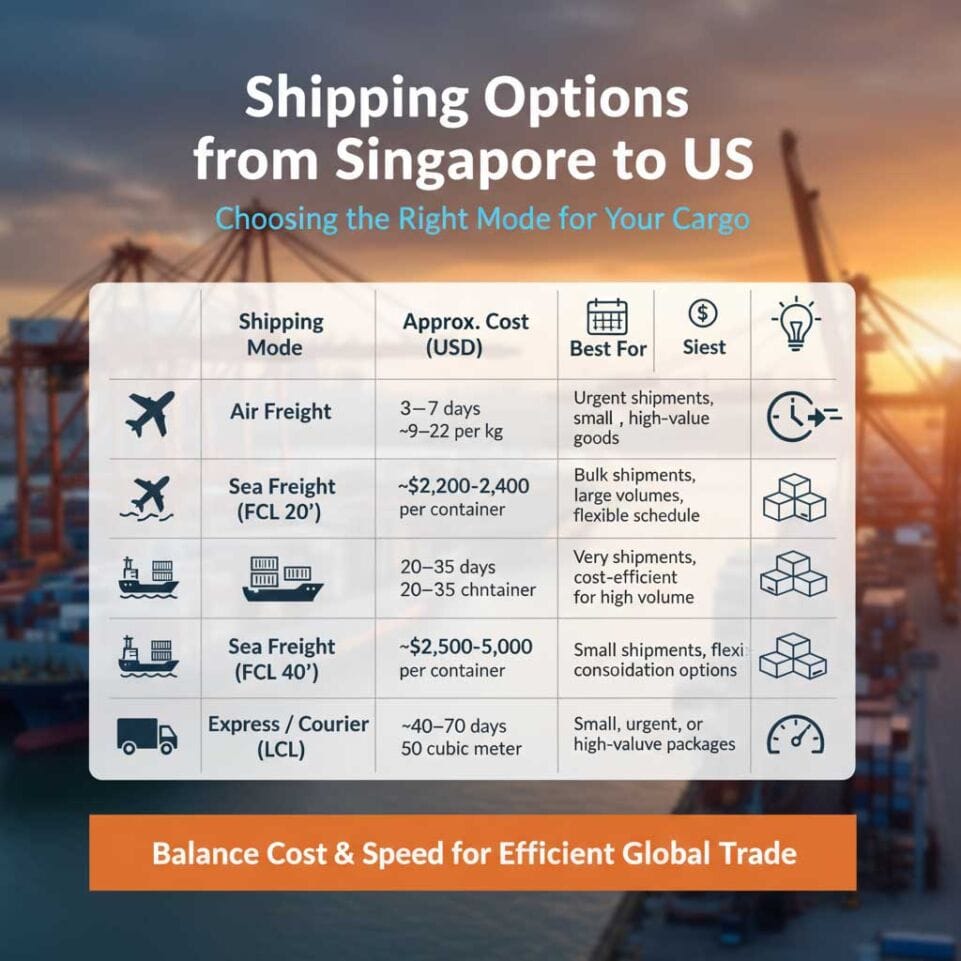
Shipping costs and transit times from Singapore to the United States vary depending on the transport method, shipment size, type of goods, and delivery urgency. Selecting the right combination of sea freight, air freight , or express courier services can help businesses balance cost and speed effectively.
Below is a clear summary of the main options for shipping from Singapore to the US:
| Shipping Mode | Transit Time | Approx. Cost (USD) | Best For |
|---|---|---|---|
| Air Freight | 3–7 days | ~$9–22 per kg | Urgent shipments, small volume, high-value goods |
| Sea Freight (FCL 20′) | 20–35 days | ~$2,200–2,400 per container | Bulk shipments, large volumes, flexible schedule |
| Sea Freight (FCL 40′) | 20–35 days | ~$2,500–5,000 per container | Very large shipments, cost-efficient for high volume |
| Sea Freight (LCL) | 20–35 days | ~$40–70 per cubic meter | Small shipments, flexible consolidation options |
| Express / Courier | 1–3 days | ~$15–25 per kg | Small, urgent, or high-value packages |
Container Types for Ocean Freight from Singapore to US
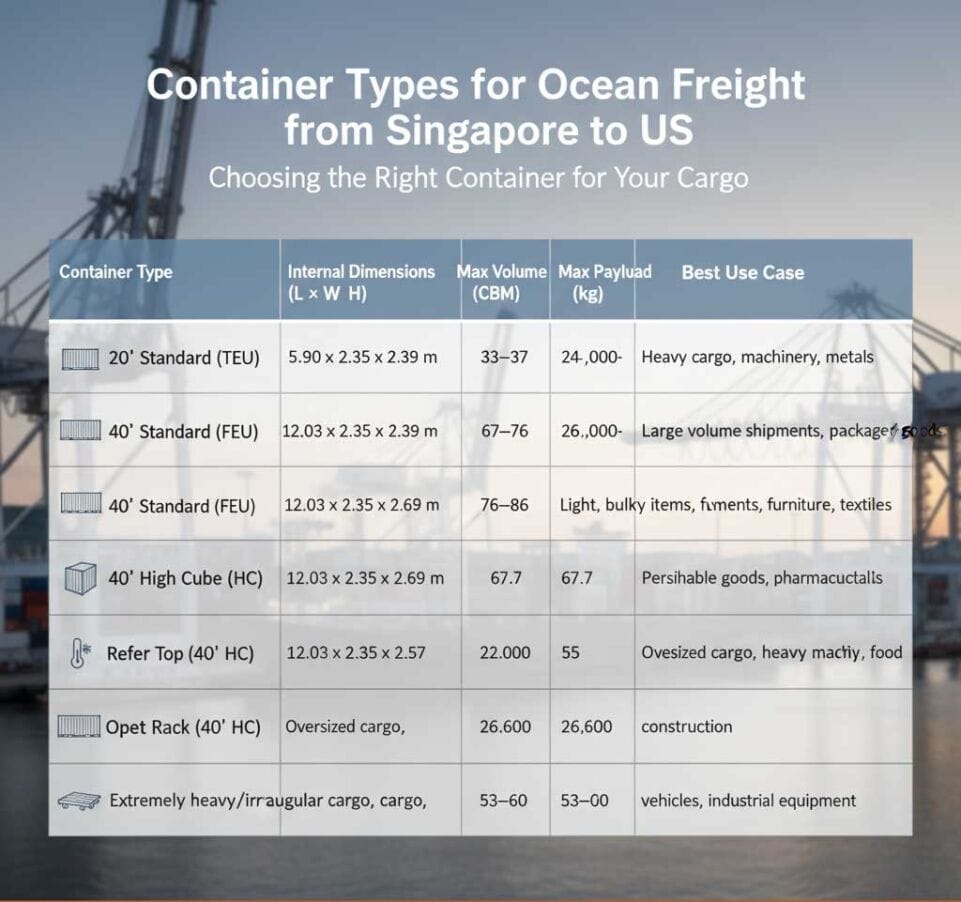
Selecting the proper container is crucial when shipping goods from Singapore to the United States. Reefer containers are ideal for items that require strict temperature control, such as food, pharmaceuticals, and other perishable products. Open-top and flat-rack containers work best for oversized, heavy, or irregularly shaped cargo that cannot fit in standard containers.
Using the right container ensures your goods arrive safely while making the most of available space, which can significantly reduce shipping costs. By understanding container types alongside transport methods, transit times, and pricing, businesses can make informed decisions that balance efficiency, cost, and delivery speed.
| Container Type | Internal Dimensions (L × W × H) | Max Volume (CBM) | Max Payload (kg) | Best Use Case |
|---|---|---|---|---|
| 20′ Standard (TEU) | 5.90 × 2.35 × 2.39 m | 33–37 | 24,000–28,000 | Heavy cargo, machinery, metals |
| 40′ Standard (FEU) | 12.03 × 2.35 × 2.39 m | 67–76 | 26,000–30,000 | Large volume shipments, packaged goods |
| 40′ High Cube (HC) | 12.03 × 2.35 × 2.69 m | 76–86 | 26,000–30,000 | Light, bulky items, furniture, textiles |
| Reefer (40′ HC) | 12.03 × 2.35 × 2.55 m | 67.7 | 22,000 | Perishable goods, pharmaceuticals, food |
| Open Top (40′ HC) | 12.03 × 2.35 × 2.67 m | 75.55 | 26,600 | Oversized cargo, heavy machinery, construction |
| Flat Rack (40′ HC) | 12.03 × 2.35 × 2.39 m | 53–60 | 25,000 | Extremely heavy/irregular cargo, vehicles, industrial equipment |
Efficient Door-to-Door Delivery from Singapore to US
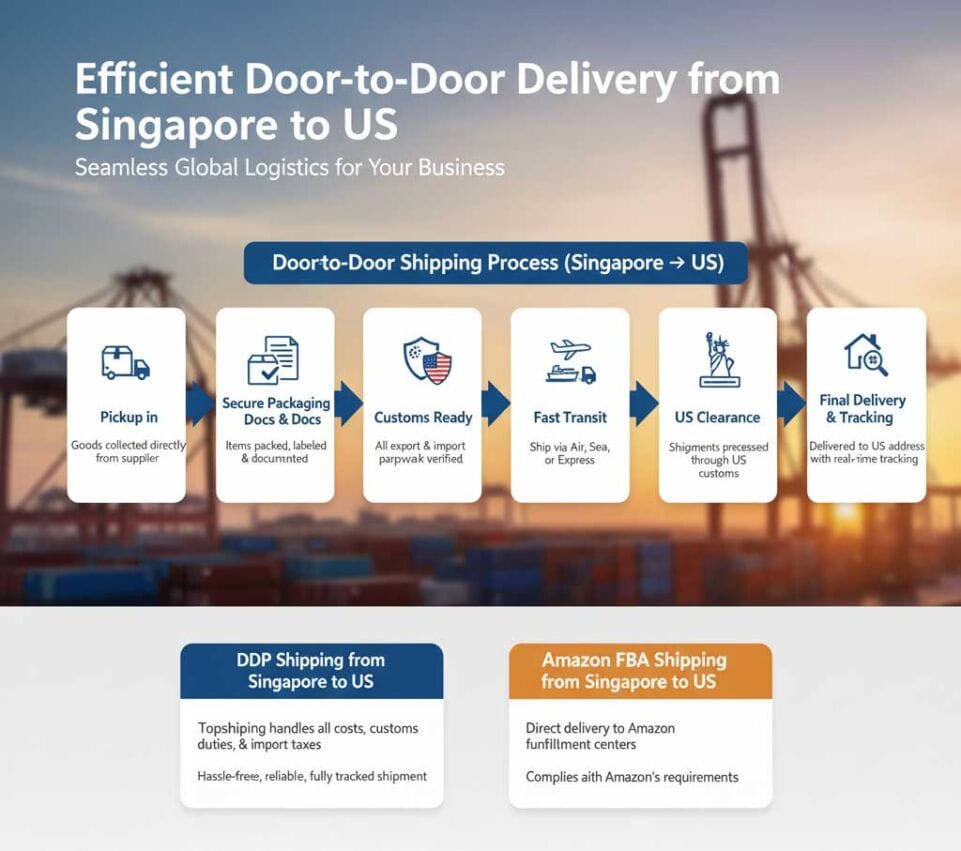
Efficient door-to-door shipping from Singapore to the United States is essential for any business looking to move goods reliably. Choosing the right shipping method whether air freight for urgent shipments or ocean freight for bulk cargo can save time and reduce costs.
Proper customs documentation, careful handling, and real-time shipment tracking help prevent delays at US ports and ensure your goods reach their destination safely. Smart planning and the right logistics partner allow companies to optimize delivery speed, cost-efficiency, and overall supply chain performance.
Door-to-Door Shipping Process (Singapore→ US)
- Pickup in Singapore: Goods are collected directly from your Singapore supplier, fully prepared for transit.
- Secure Packaging: Items are carefully packed, labeled, and documented to prevent delays.
- Customs Ready: All Singapore export and US import paperwork is verified for smooth clearance.
- Fast Transit: Ship via Air, Sea, or Express depending on urgency, size, and budget.
- US Clearance: Shipments are efficiently processed through US customs.
- Final Delivery: Cargo is safely delivered to your US destination with proof of receipt.
- Full Tracking & Support: Monitor your shipment in real-time with expert assistance throughout the journey.
DDP Shipping from Singapore to US
DDP Shipping from Singapore to the US with Topshipping means we handle all shipping costs, customs duties, and import taxes for you.
Your goods are picked up, securely packed, cleared through Singapore and US customs, and delivered directly to your US address.
This ensures a hassle-free, reliable, and fully tracked shipment from start to finish.
Amazon FBA Shipping from Singapore to US
Topshipping makes shipping to Amazon FBA in the US simple and reliable. We handle pickup from your Singapore supplier, secure packaging, customs clearance, and delivery directly to Amazon fulfillment centers.
With our service, your shipments comply with Amazon’s requirements, arrive on time, and are fully tracked, ensuring a smooth, hassle-free process for your FBA business.
Shipping from Singapore to US Transit Time

For B2B importers shipping from Singapore to the US, understanding accurate transit times is crucial for maintaining inventory levels and meeting client expectations.
Actual delivery can vary depending on your chosen shipping method, the completeness of documentation, and seasonal demand fluctuations.
To simplify your planning, we provide a comprehensive guide detailing all shipping options, transit times, and estimated costs, helping you select the fastest, most reliable, and cost-effective solution for your shipments from Singapore to the US.
| Shipping Method | Transit Time (Singapore → US) | Customs Clearance & Handling | Total Estimated Delivery Time (Door-to-Door) | Best Suited For |
|---|---|---|---|---|
| Express Courier (DHL, FedEx, UPS) | 2–5 days | Handled by courier | 3–7 days | Urgent samples, small high-value items, documents |
| Air Freight | 5–8 days | 1–3 days | 6–11 days | Time-sensitive inventory, electronics, fashion goods |
| Sea Freight (FCL 20′/40′) | 20–30 days | 2–5 days | 22–35 days | Large volumes, machinery, industrial products |
| Sea Freight (LCL) | 22–32 days | 3–6 days | 25–38 days | Small to medium shipments, consolidated cargo |
Transit Time Factors and Solutions
- Pick the Most Efficient Transport: Choose Air, Sea, or Express based on how quickly you need your goods, their size, and your budget.
- Schedule Early: Reserving space in advance prevents delays, especially during peak shipping seasons.
- Prepare Flawless Documentation: Accurate invoices, certificates, and permits ensure smooth customs clearance in both Singapore and the US.
- Use Real-Time Tracking: Continuous monitoring helps you address issues immediately if unexpected delays occur.
- Partner with Trusted Logistics Experts: Working with experienced forwarders like Topshipping guarantees careful handling, timely clearance, and reliable delivery.
Holiday & Peak Season Considerations for Shipping from Singapore to US
Shipping during holidays or peak seasons, such as Black Friday, Christmas, or Lunar New Year, can impact transit times and costs for shipments from Singapore to the US.
Increased demand often leads to full bookings, port congestion, and higher freight rates.
Shipping Costs & Transparent Pricing
For B2B importers sending goods from Singapore to the US, knowing the full landed cost is crucial for effective financial planning.
Shipping expenses can fluctuate based on transport mode, cargo size, and seasonal demand, and include more than just freight. Importers must also factor in customs duties, US taxes, port handling fees, and documentation costs.
By estimating all costs upfront, businesses can avoid surprises, protect their margins, and ensure a seamless supply chain, keeping inventory on track and deliveries punctual.
| Shipping Method | Cost Range (USD) | Minimum Charge (USD) | Best Suited For | Estimated Transit Time (Door-to-Door) |
|---|---|---|---|---|
| Express Courier (DHL, FedEx, UPS) | $10 – 18 per kg | $50 – $70 | Urgent documents, small electronics, samples | 2 – 5 days |
| Air Freight | $3 – 5 per kg | $300 – $350 | Time-sensitive goods, consumer products, fashion items | 5 – 9 days |
| Sea Freight (FCL 20′ / 40′) | $700 – 1,500 per container | N/A | Bulk shipments, heavy machinery, industrial cargo | 18 – 28 days |
| Sea Freight (LCL) | $40 – 60 per CBM | $160 – $200 | Small to medium shipments, consolidated cargo, retail goods | 20 – 30 days |
| Rail Freight | $15 – 35 per CBM | N/A | Industrial products, raw materials | 12 – 20 days |
Factors Affecting Shipping Costs from Singapore to USA
Shipping expenses from Singapore to the United States depend on a mix of practical and logistical factors:
- Mode of Transport: Choosing between air, express, or sea impacts cost significantly; faster options like air and courier are pricier, while sea freight offers more economical rates for bulk shipments.
- Shipment Size & Weight: Large or heavy cargo increases costs, whereas smaller, consolidated shipments LCL (Less than Container Load)can help save money.
- Nature of Goods: Fragile, perishable, or hazardous items need special handling, which adds to the charges.
- Peak Seasons: Demand surges around holidays like Christmas or Black Friday can lead to higher freight rates and limited availability.
- Fuel and Port Fees: Fluctuating fuel costs, port surcharges, and security fees affect the total shipping cost.
- Customs & Taxes: US import duties, tariffs, and handling fees must be included to calculate the final landed cost.
- Pickup & Delivery Locations: Shipping from smaller Singapore warehouses or delivering to remote US regions usually costs more than standard hub-to-hub routes.
Common Import Duty Examples for USA
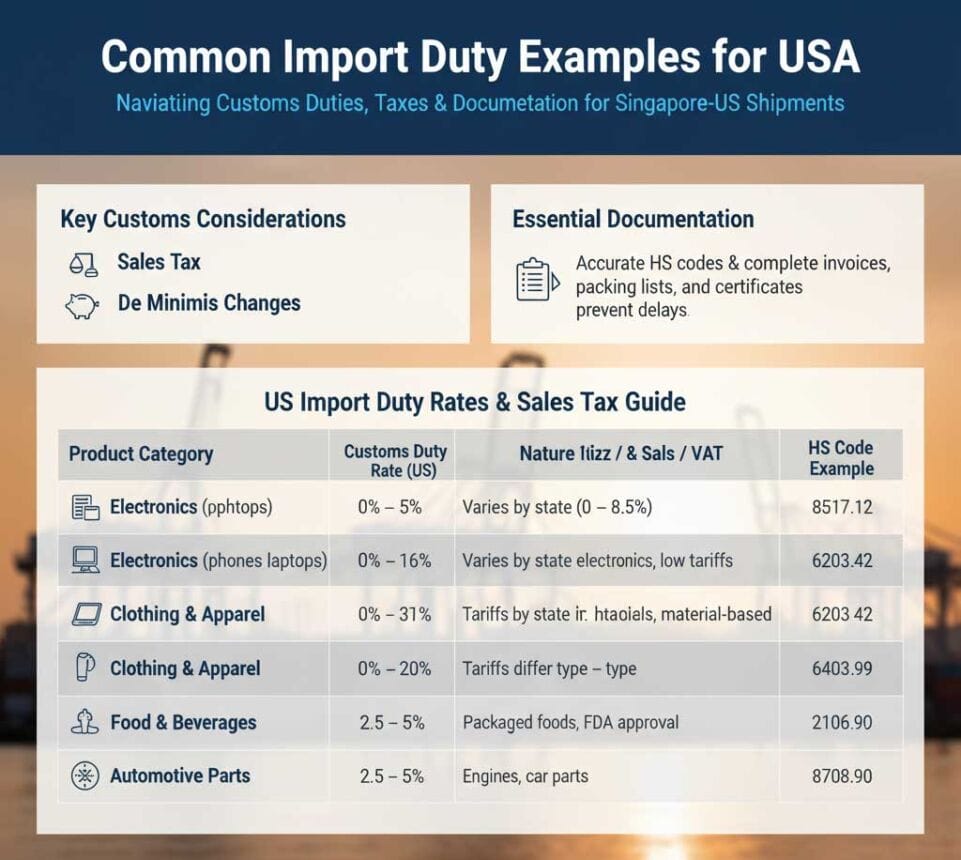
B2B importers shipping from Singapore to the US must consider customs duties, taxes, and proper documentation.
- Customs Duties: Vary by HS code; consumer goods often range from 2.5%–6%, while some products can reach 37.5%.
- Sales Tax: Applied at the state level, e.g., California charges 7.25% on most goods.
- De Minimis Changes: Since August 2025, even low-value shipments (<$800) may incur duties and fees.
Documentation & HS Classification: Accurate HS codes and complete invoices, packing lists, and certificates prevent delays and extra costs.
| Product Category | Customs Duty Rate (US) | Sales Tax / VAT | Notes |
|---|---|---|---|
| Electronics (phones, laptops) | 0% – 5% | Varies by state (0% – 8.5%) | Consumer electronics; low tariffs on most small devices |
| Clothing & Apparel | 0% – 16% | Varies by state | Includes garments, textiles; tariffs depend on material and origin |
| Footwear | 0% – 37.5% | Varies by state | Tariffs differ by type (leather, synthetic, athletic) |
| Toys & Games | 0% – 5% | Varies by state | Includes educational toys and general children’s items |
| Machinery & Industrial Equipment | 0% – 5% | Varies by state | Industrial machines, production tools |
| Furniture | 0% – 3% | Varies by state | Home and office furniture; shipping cost may influence duty calculation |
| Cosmetics & Personal Care | 0% – 6% | Varies by state | Skincare, haircare, beauty products |
| Sports Equipment | 0% – 8% | Varies by state | Fitness gear, bicycles, sporting goods |
| Books & Stationery | 0% | Varies by state | Printed books, office supplies |
| Automotive Parts | 2.5% – 5% | Varies by state | Engines, car parts, accessories |
| Food & Beverages | 0% – 20% | Varies by state | Packaged foods, beverages; some require FDA approval |
| Medical Equipment | 0% – 3% | Varies by state | Hospital tools, diagnostic equipment |
| Textiles & Fabrics | 0% – 16% | Varies by state | Raw fabrics, yarns, rolls; tariffs depend on material origin |
US Customs & Import Documentation Requirements
For shipments from Singapore to the United States, having the correct customs documents is essential for smooth and timely delivery.
Proper paperwork ensures your goods are classified correctly, valued accurately, and meet all US import regulations.
While some documents are required for every shipment, certain goods such as electronics, food, or pharmaceuticals may need additional certifications or permits.
Understanding and preparing the right documents in advance helps avoid delays, prevent fines, and reduce unexpected costs.
| Document Type | Required For | Purpose / Notes |
|---|---|---|
| Commercial Invoice | All imports | Declares the value, description, and quantity of goods for US customs. Accuracy ensures proper duty calculation and prevents delays or fines. |
| Packing List | All shipments | Details the contents of each package for inspection and verification by US Customs. Helps streamline clearance. |
| Bill of Lading / Air Waybill (AWB) | Sea, air, or express shipments | Serves as proof of shipment and the contract between shipper and carrier. |
| Importer Security Filing (ISF) | Ocean shipments | Mandatory filing before cargo departs Singapore. Provides US Customs with advance shipment information. |
| Customs Bond | Commercial imports | Guarantees payment of duties, taxes, and compliance with US import regulations. |
| Certificate of Origin | Goods eligible for preferential tariffs | Confirms the origin of products to claim any trade agreement benefits (if applicable). |
| Compliance Certificates / Licenses | Electronics, medical devices, chemicals, food | Ensures imported goods meet US safety, health, and regulatory standards. |
| Tax Identification / Business Registration | All commercial imports | Required for customs clearance, duty payments, and reporting. |
| Insurance Certificate | All shipments | Proof of coverage for loss or damage during transit; often requested by buyers or freight forwarders. |
| Proforma Invoice | Samples, quotations, pre-shipment approval | Used for preliminary customs assessment, cost estimation, or import approvals. |
Customs Clearance Tips for Shipping to US
- Complete & Correct Documentation: Ensure commercial invoices, packing lists, certificates of origin, and any special licenses are accurate. Mistakes can lead to inspection delays or fines.
- Accurate HS Code Assignment: Classify each product correctly using US Harmonized Tariff Schedule codes to determine applicable duties and avoid misclassification penalties.
- Comply with Regulatory Requirements: Verify whether products require FDA, USDA, or EPA approvals, especially for food, cosmetics, medical devices, or electronics.
- Pre-Pay Duties and Fees When Possible: Calculating and pre-paying estimated tariffs and state taxes prevents unexpected costs and smooths delivery.
- Partner with a Licensed US Customs Broker: Experienced brokers can handle filings, resolve issues quickly, and guide compliance with changing regulations.
- Monitor Shipments Proactively: Track cargo in real-time and respond immediately to any US Customs queries to minimize hold-ups.
- Plan for Seasonal Variations: Peak periods, like Black Friday or holiday seasons, can delay clearance. Book shipments early and allow buffer time.
- Use Correct Packaging and Labeling: Properly labeled and packaged shipments reduce inspection time and improve compliance with US customs standards.
Customs Clearance Methods & Incoterms for Shipping Singapore to US
| Incoterm | Seller’s Responsibility | Buyer’s Responsibility | Best For | Estimated Transit Time (Singapore → US) | Cost Responsibility |
|---|---|---|---|---|---|
| DDP Incoterm (Delivered Duty Paid) | Handles shipping, insurance, US customs duties, taxes, and door-to-door delivery | Receive goods | Importers wanting hassle-free, all-inclusive delivery | Sea: 15–25 days / Air: 3–6 days | Seller covers freight, insurance, US import duties, taxes, and final delivery |
| DAP incoterm (Delivered At Place) | Delivery to US port or warehouse | Customs clearance, duties, taxes, and inland delivery | Importers managing customs locally | Sea: 12–22 days / Air: 2–5 days | Buyer pays duties, taxes, and inland transport; seller covers freight to arrival point |
| CIF incoterm(Cost, Insurance, Freight) | Freight and insurance to US port | Customs clearance, duties, taxes, and inland delivery | Port-to-port shipments needing insurance coverage | Sea: 12–22 days | Seller pays freight and insurance; buyer handles duties, taxes, and inland transport |
| FOB Incoterm(Free On Board) | Goods delivered and loaded onto vessel at Singapore port | International freight, insurance, customs, taxes, and delivery | Importers managing their own shipping & logistics | Depends on chosen freight | Buyer pays all costs from port of loading onward |
Prohibited and Restricted Items
Shipping to Singapore may look simple due to its strong logistics infrastructure, but strict import regulations apply. Some goods are banned entirely, while others need permits from agencies like the Singapore Customs or the Agri-Food & Veterinary Authority. Ignoring these requirements can result in fines, shipment rejection, or legal issues.
For smoother operations, we’ve created a detailed table of restricted and prohibited goods in Singapore. This resource helps businesses prepare documents correctly and avoid unnecessary clearance problems.
| Category | USA – Prohibited / Restricted Items | Singapore – Prohibited / Restricted Items |
|---|---|---|
| Dangerous Goods & Weapons | Prohibited: Fully automatic firearms, silencers, explosives, switchblades, chemical weapons Restricted: Certain rifles, ammunition, pepper spray – ATF license required | Prohibited: Firearms, explosives, switchblades, knuckle dusters, pepper spray Restricted: Air guns, pyrotechnics, certain chemicals – license from Singapore Police Force needed |
| Endangered Species & Cultural Artifacts | Prohibited: Ivory, rhino horn, endangered wildlife products, stolen cultural property Restricted: Antiques, protected artifacts – permits from U.S. Fish & Wildlife Service/CBP | Prohibited: Ivory, pangolin scales, products from endangered species Restricted: Antiques, cultural property – CITES or National Heritage Board approval required |
| Food, Alcohol & Agricultural Products | Prohibited: Raw meat, unpasteurized milk, fresh produce with soil/pests Restricted: Alcohol above limits – requires permits; certain crops need USDA inspection | Prohibited: Chewing gum (non-medicinal), unlicensed meat, fresh milk without approval Restricted: Alcohol over duty-free limits, processed foods – must meet SFA rules |
| Cosmetics & Personal Care | Prohibited: Products with mercury, banned substances Restricted: Must comply with FDA safety & labeling rules | Prohibited: Unsafe cosmetics (e.g., with hydroquinone/tretinoin without prescription) Restricted: Must meet HSA (Health Sciences Authority) regulations |
| Medical Devices & Pharmaceuticals | Prohibited: Counterfeit drugs, unapproved medicines, controlled substances Restricted: FDA-approved drugs only with valid prescription | Prohibited: Counterfeit/unregistered medicines, narcotics Restricted: Prescription drugs & medical devices require HSA approval |
| Currency & Valuables | Prohibited: Counterfeit money, stolen securities Restricted: Cash over USD 10,000 must be declared | Prohibited: Counterfeit currency, illegal financial instruments Restricted: Cash over SGD 20,000 must be declared |
| Electronics & Batteries | Prohibited: Unsafe/counterfeit electronics Restricted: Lithium batteries, drones, telecom devices – FAA/FCC approval required | Prohibited: Non-compliant electronics, unsafe adapters Restricted: Lithium batteries, drones, telecom devices – IMDA approval required |
Key Ports in Singapore and USA for Shipping
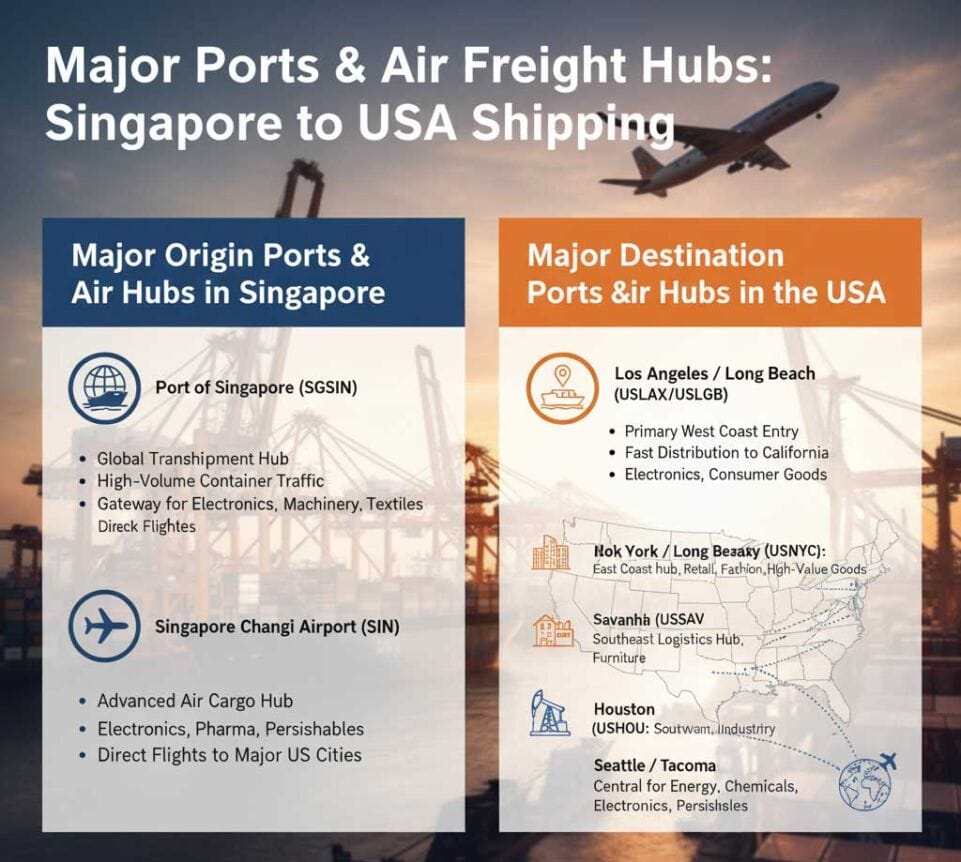
Major Origin Port in Singapore for Shipments to the USA
Port of Singapore (SGSIN): One of the busiest transshipment hubs globally, handling high-volume container traffic with advanced logistics facilities. It serves as the central gateway for electronics, machinery, textiles, and general cargo moving toward the U.S.
Major Destination Ports in the USA
- Los Angeles/Long Beach (USLAX/USLGB): The primary entry point on the West Coast, ideal for fast distribution to California and western states.
- New York/New Jersey (USNYC): A leading East Coast hub, serving retail, fashion, and high-value goods bound for the northeastern U.S.
- Savannah (USSAV): A growing logistics hub in the southeast, well-suited for consumer goods, furniture, and industrial imports.
- Houston (USHOU): A central port for energy, chemicals, and heavy machinery, with strong inland connections.
- Seattle/Tacoma (USSEA/USTIW): Key gateway for electronics, perishables, and high-tech goods entering the U.S. Northwest.
Major Air Freight Hubs for Singapore to US Shipments

Airport in Singapore
Singapore Changi Airport (SIN): One of the world’s most advanced air cargo hubs, specializing in electronics, pharmaceuticals, perishables, and high-value shipments. Its strategic location and daily direct flights to major U.S. cities make it the central gateway for air freight from Southeast Asia to America.
Major Airports in the United States
- Los Angeles International Airport (LAX): West Coast hub for consumer electronics, e-commerce, and retail products, offering fast distribution across California and western states.
- Chicago O’Hare International Airport (ORD): Central U.S. hub ideal for machinery, industrial goods, and time-sensitive cargo, with extensive rail and trucking links.
- John F. Kennedy International Airport (JFK): Primary East Coast entry point for fashion, luxury goods, and pharmaceuticals, serving New York and surrounding regions.
- Miami International Airport (MIA): Key hub for perishables, textiles, and Latin America transshipments.
- Dallas/Fort Worth International Airport (DFW): Strategic hub for electronics, automotive, and high-tech cargo, linking to the southern and central U.S. markets.
Shipping Platforms & Freight Partners for Singapore to USA
DHL Express – Speed & Reliability
- Transit Time: 3–5 business days from major hubs in Singapore or China to U.S. destinations like New York, Los Angeles, and Chicago.
- Coverage: Door-to-door service with strong infrastructure in both metropolitan and regional areas.
- Best For: Urgent shipments, electronics, medical supplies, and high-value goods.
- TopShipping Insight: Ideal for businesses needing fast delivery, end-to-end tracking, and guaranteed timelines.
FedEx International Priority – Flexible & Consistent
- Transit Time: 4–6 business days depending on origin and U.S. port of entry.
- Coverage: Efficient for e-commerce, small to medium parcels, and samples.
- Best For: Merchants requiring reliable customs clearance and timely deliveries.
- TopShipping Insight: Excellent for frequent exporters who value consistency and professional support.
UPS Worldwide Express – B2B & Bulk-Friendly
- Transit Time: 5–7 business days with integrated ground distribution in the U.S.
- Coverage: Supports large shipments, Amazon FBA inventory, and B2B deliveries efficiently.
- Best For: High-volume exporters handling heavy or bulk cargo.
- TopShipping Insight: Perfect for companies managing tight schedules and heavier consignments with minimal hassle.
International Freight Forwarder from Singapore to USA
With TopShipping, your cargo moves fast and securely whether you’re shipping from China to the US or Singapore to the US. Enjoy hassle-free, door-to-door delivery from your supplier straight to your warehouse or customer, with reliable tracking and professional handling every step of the way.
How to Select the Right Freight Forwarder for USA?
Selecting a reliable freight forwarder is crucial to ensure smooth and cost-effective shipments from Singapore to the United States. Consider these key factors:
- Experience & Expertise: Choose a forwarder familiar with U.S. customs, import regulations, and major ports and airports.
- Service Coverage: Ensure they handle sea, air, and express shipping, including customs clearance and last-mile delivery.
- Reliability & Reputation: Check reviews, references, and track records of on-time deliveries.
- Transparent Pricing: Look for clear quotes covering freight, duties, taxes, and any additional fees.
- Communication & Support: Opt for partners providing proactive updates, real-time tracking, and responsive customer service.
Top Tip: Partnering with an experienced forwarder like TopShipping guarantees your shipments from Singapore or China to the U.S. arrive safely, on schedule, and fully compliant with all regulations.
Shipping Made Simple: From Singapore to USA in Easy Steps
1. Define Your Shipment Needs
Know your cargo type, size, and weight to decide between air, sea, or express shipping.
2. Select the Right Shipping Method
- Air freight: 3–7 days, best for urgent or high-value goods.
- Sea freight: 20–35 days, cost-effective for bulk shipments.
3. Partner with a Trusted Freight Forwarder
Choose a forwarder with experience in Singapore–USA trade who can manage door-to-door delivery.
4. Get a Clear Quote
Ask for detailed pricing including freight, handling, customs, and delivery fees to avoid hidden costs.
5. Prepare Shipping Documents
Key paperwork:
- Commercial Invoice
- Packing List
- Bill of Lading (B/L) or Air Waybill (AWB)
- Certificates or permits if required
6. Pack Goods Properly
Use export-standard packaging and labeling to meet airline, shipping line, and U.S. Customs requirements.
7. Arrange Export Clearance in Singapore
Your forwarder submits export declarations to Singapore Customs before cargo departs.
8. Manage Transit & Tracking
Track your shipment throughout its journey by sea or air for better visibility and planning.
9. Handle U.S. Customs Clearance
Provide correct HS codes, pay duties/taxes, and ensure compliance with U.S. regulations (FDA, EPA, etc. if applicable).
10. Inland Transportation in USA
Once cleared, goods are moved to warehouses or final destinations via trucking or rail.
11. Delivery & Confirmation
Receive your goods, check condition, and confirm successful delivery with your forwarder.
Final Review
Shipping goods from Singapore to the USA can be seamless and cost-efficient when planned properly. By selecting the right shipping method, using accurate Incoterms , and preparing all required documentation, businesses can avoid customs delays and unexpected charges. Compliance with U.S. import regulations is key to smooth clearance and timely delivery. With an experienced partner like TopShipping, your cargo moves from Singapore to any U.S. destination quickly, securely, and ready for final distribution whether it’s by air or ocean freight.
FAQs: Shipping to USA
Can Rail Freight be used for shipping from Singapore to the USA?
Direct rail freight is not available between Singapore and the United States due to the Pacific Ocean. However, businesses can combine rail with sea or air freight through multimodal solutions. For example, cargo may move by rail within Asia to Chinese or transshipment hubs, then continue by ocean or air to the U.S. This option can sometimes reduce costs and balance transit time
Can I use road freight directly from Singapore to the USA?
No, direct road freight isn’t possible due to the Pacific Ocean. Instead, trucks are used within Singapore for port delivery and in the U.S. for inland transport after sea or air freight.
How is truck transportation used in Singapore–USA shipments?
Trucking services move goods from factories or warehouses in Singapore to the port or airport, and on the U.S. side, trucks deliver cargo from ports like Los Angeles, New York, or Houston to the final destination.
How long does inland trucking take in the USA after arrival?
It depends on the port and destination. For example, Los Angeles to Dallas may take 2–3 days by truck, while New York to Chicago is around 1–2 days.
Do I need a freight forwarder for road freight in the U.S.?
Yes. A freight forwarder can arrange seamless multimodal transport, combining sea or air freight with trucking, customs clearance, and final delivery.
